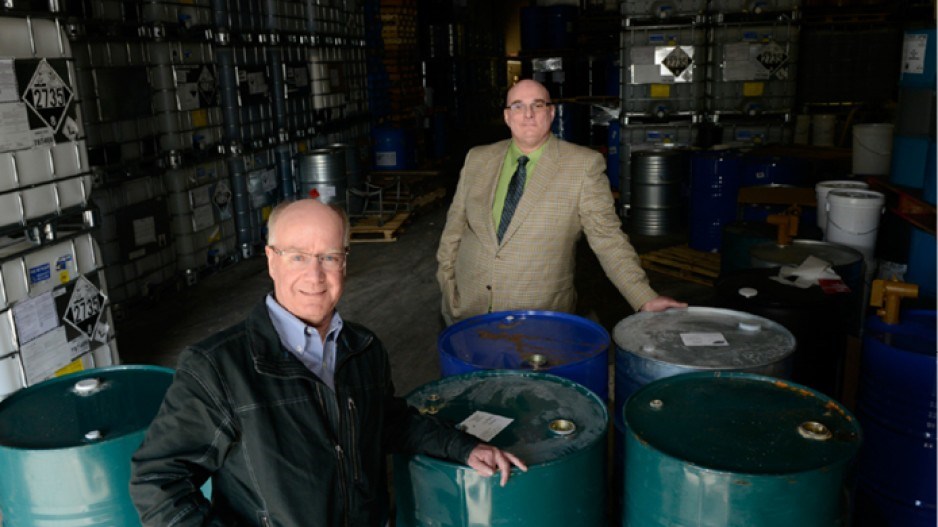David Rowat's office sits amid auto repair shops and wrecking yards next to the Patullo Bridge. While his building doesn't seem of much significance, workers at a green-tech startup inside spend their days developing environmental alternatives to toxic solvents.
“What we do here in terms of mixing chemicals, which are inherently dangerous goods, you're not going to do that in a Class AA office space in downtown Vancouver,” said Rowat, CEO of TBF Environmental Technologies. “This is, right now, the best place for us to be because it is heavily industrialized.”
With an abundance of relatively cheap land to support its role as a booming bedroom community, Surrey was a developer's haven for years. Townhouse complexes, mini-mansions and strip malls all flourished between the big pockets of industrial land and parks.
But in 2005, Surrey's current mayor, Dianne Watts, campaigned against incumbent Doug McCallum on a platform emphasizing sustainable development.
Within three years, the city developed a sustainability charter.
“Developers will be quick to tell you it is much more difficult these days to develop property than it ever has been. And I don't think, in some respects, that that's a bad thing,” said Coun. Bruce Hayne, chairman of the city's environmental sustainability advisory committee.
Unimpeded development would hurt Surrey's viability as a place to live and work, according to Hayne.
In May 2014, city council added the Green Surrey program to the charter.
The program is aimed at fostering the development of sustainable and environmentally friendly infrastructure as well as promoting the emerging green business sector.
Surrey's new city hall and downtown library already boast geothermal heating and cooling systems, while construction of a $65 million biofuel facility in the Port Kells neighbourhood is set to conclude in 2015 and fuel the city's fleet of waste collection vehicles.
Hayne said the city is in a “crucial” period in the development of its green economy.
In the same way that it hired Simon Fraser University (SFU) neuroscientist Ryan D'Arcy to help guide the emerging med-tech sector in the city's Innovation Boulevard, city hall is now searching for a leader for its clean energy industry.
The new chairperson would team with BC Hydro's Powertech Labs and SFU's Surrey campus to kick-start a centre of excellence for green startups.
But Hayne acknowledged that launching a clean-tech sector has been more challenging than ushering in med-tech.
While startups like TBF Environmental or Endurance Wind Power are having success in Surrey, the councillor said many investors have been turned off by the clean-tech sector because the return on investment takes longer.
Hayne said it's up to Surrey to focus on its strengths – particularly its abundance of the affordable industrial land that green-tech startups need.
“Doing things in a ‘green' manner is not a burden on business,” he said. “It can be extremely profitable as well, and we can do it in a profitable manner.”
While Surrey's green economy strategy is just getting started, Vancouver recently released its second report tracking the sector, showing that green jobs in that city grew 19% between 2010 and 2013.
The number of green jobs in Vancouver climbed from 16,700 in 2010 to 20,000 in 2013, according to the report. The sector currently represents 4.9% of the city's economy, and the City of Vancouver wants to double the number of green jobs over 2010 levels by 2020.
A portion of that growth can be credited to local food businesses, a sector that was included in the report for the first time in 2014. Retroactively measuring local food boosted the 2010 numbers by 6,169 jobs. That sector had higher job growth than the other areas, which include green buildings, clean technology, environmental remediation and recycling.
The rationale for putting local food under the green economy umbrella is that food produced close to home has a lower carbon footprint, said Juvarya Veltkamp, manager of green economy initiatives at the Vancouver Economic Commission (VEC).
Local food, she said, is also part of the city's Greenest City plan.
“I don't think anyone had predicted how fast both local food and green buildings [jobs] grew. They were both double-digit growth.”
Meanwhile, growth was slower than expected for clean-tech and environmental remediation jobs. Back in 2010, investors were optimistic about investment in clean technology, but globally the sector has had a tough time attracting capital.
“VEC has a strategy to take our local clean-tech entrepreneurs and startup entrepreneurs to connect them to markets wherever they are,” Veltkamp said. “We support pitch sessions to some of the key capital markets like Asia and California.”
But the size and shape of the green economy is notoriously difficult to measure, said Ken Peacock, a Business Council of British Columbia (BCBC) economist.
The methodology used not just by the VEC but by organizations like the U.S. Bureau of Labor Statistics involves reclassifying some existing jobs, such as food truck operators and bus drivers, as green.
“It's worth doing because there is this general interest out there about the size of the green economy,” said Peacock, who warned that the green economy is still a very small slice of Vancouver's overall jobs picture.
While Peacock would like to see the VEC focus more on high-paying jobs, whether they're green or not, in general “more employment is good for Vancouver.”
He noted that Vancouver has high living costs but relatively low wages when compared with other Canadian cities.
While Vision Vancouver's political rivals have scoffed at the city's “greenest city” aspirations, Peacock said efforts to track the green economy could help build the city's green brand, which in turn could attract clean-tech and other environmental businesses.
“It's a growth area,” he said.




